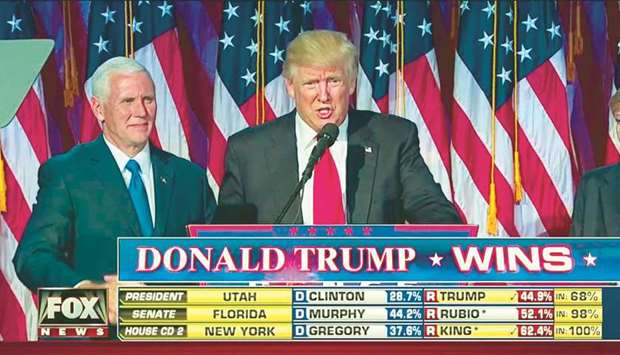The US electoral college was an unwanted child from the beginning. Born in Philadelphia in mid-August 1787, when most delegates to the Constitutional Convention were eager to escape the heat and humidity and go home, it was the fruit of a compromise between the two warring factions at the convention: those who wished to revise the Articles of Confederation and retain sovereignty in the states, and those who wished to replace the articles by shifting sovereignty to a fully empowered national government. In effect, should the United States remain a confederation or become a nation-sized republic?
There was no consensus on an answer to that question, and the electoral college accurately reflected the impasse. Neither side was happy with the result. James Madison, at this stage of his career an ardent nationalist, left Philadelphia in September believing that he had failed. Later, as the Father of the Constitution, Madison confided to friends that the document he had just signed was fatally flawed because the principle of state sovereignty survived in two places, the Senate (where small states get the same vote as big states) and the electoral college (where votes again aren’t apportioned by population only). Although it began “We the people,” the Constitution did not really mean those words, Madison said, and for that reason, would not last for long.
More than two centuries later, Madison’s prediction has long since died a natural death. In fact, the US Constitution became the political model for all aspiring liberal governments in the modern era, with one glaring exception: No country in the world adopted the electoral college.
Foreign coverage of American presidential elections can resemble Marx Brothers comedy skits, mocking the distinction between voters and electors. (One French commentator joked that the distinction resembled the medieval difference between equants and epicycles in the Ptolemaic universe.) The recent election of Donald Trump, who won the presidency with a smaller percentage of the popular vote than Mitt Romney did in losing it, generated some combination of bewilderment and outrage through a traumatised electorate.
All of which rises to an obvious question: If the framers who created the electoral college regarded it as an ugly compromise; if no one else in the world copies it, admires it or understands it; if its recent product is the most unqualified and embarrassing president in American history; why has it not followed the same fate as powdered wigs and the property qualification to vote?
The short answer is that the Americans stuck with it. The longer version is that the framers deliberately made it difficult to amend the Constitution, requiring a two-thirds vote in both houses of Congress and a three-quarters supermajority of all the states.
Ironically, the electoral college resists replacement for the same reason it needs to be replaced: the unrepresentative power of states with small populations. Any proposed constitutional amendment must first negotiate the gantlet in the Senate, where the Dakotas, with less than half the population of Los Angeles, control twice the votes of California.
It must then achieve a supermajority among the 50 states, where Vermont and Rhode Island have the same clout as New York or Pennsylvania. Think of it as the constitutional version of a Catch-22.
For these reasons, all previous attempts to abolish the electoral college recall the tale of Sisyphus rolling the boulder up a hill. There are sound reasons to conclude that a constitutional amendment making presidential elections more democratic is and always will be a bridge too far.
On the other hand, Madison and a small coterie of his colleagues, chiefly George Washington, Alexander Hamilton and John Jay, decided to cross just such a bridge in 1787. In the face of implacable opposition, they somehow performed the impossible task of replacing the Articles of Confederation with the Constitution. Historians often call it the miracle at Philadelphia.
Let me suggest that, after Trump’s election, Americans occupy an opportune moment to try their own hands at making a miracle. Popular frustrations are ripe for harvesting during the election of 2020, which needs to become a referendum not just on Trump’s presidency, but also on the electoral college that, more than Russian hackers, made it possible.
All presidential candidates from both parties should be required to answer the following question: “Do you favour replacing the electoral college with the direct popular election of the president?” Throughout the primary season, “We the People” banners and T-shirts should appear at Democratic and Republican rallies, as well as anywhere citizens gather to express themselves on the issues at stake in the campaign. The goal is to generate and fully expose an overwhelming mandate for reform.
Meanwhile, at the state level, a complementary movement, let’s call it Electors for Democracy, can recruit and support electors who pledge to cast their votes for whoever wins the national popular vote. (An organised effort along these lines is already underway in several states.) There is nothing in the Constitution that requires an elector to vote for the winner in his or her state, a loophole that might offer a way around the amendment impasse. The debate it generates will make the effort itself worthwhile.
There are undoubtedly other legal and political approaches that will occur to more imaginative advocates of electoral reform once the dialogue gets going. The people should be poised to try anything that works. Upending the electoral college might very well take years, but the great debate must begin now. The opportunity is ripe, the problem is serious, the solution is obvious, and, for the faint of heart, Madison is up there cheering us along. – Tribune News Service
* Joseph J. Ellis’ latest book is American Dialogue: The Founders and Us.

Upending the electoral college might very well take years, but the great debate must begin now.


